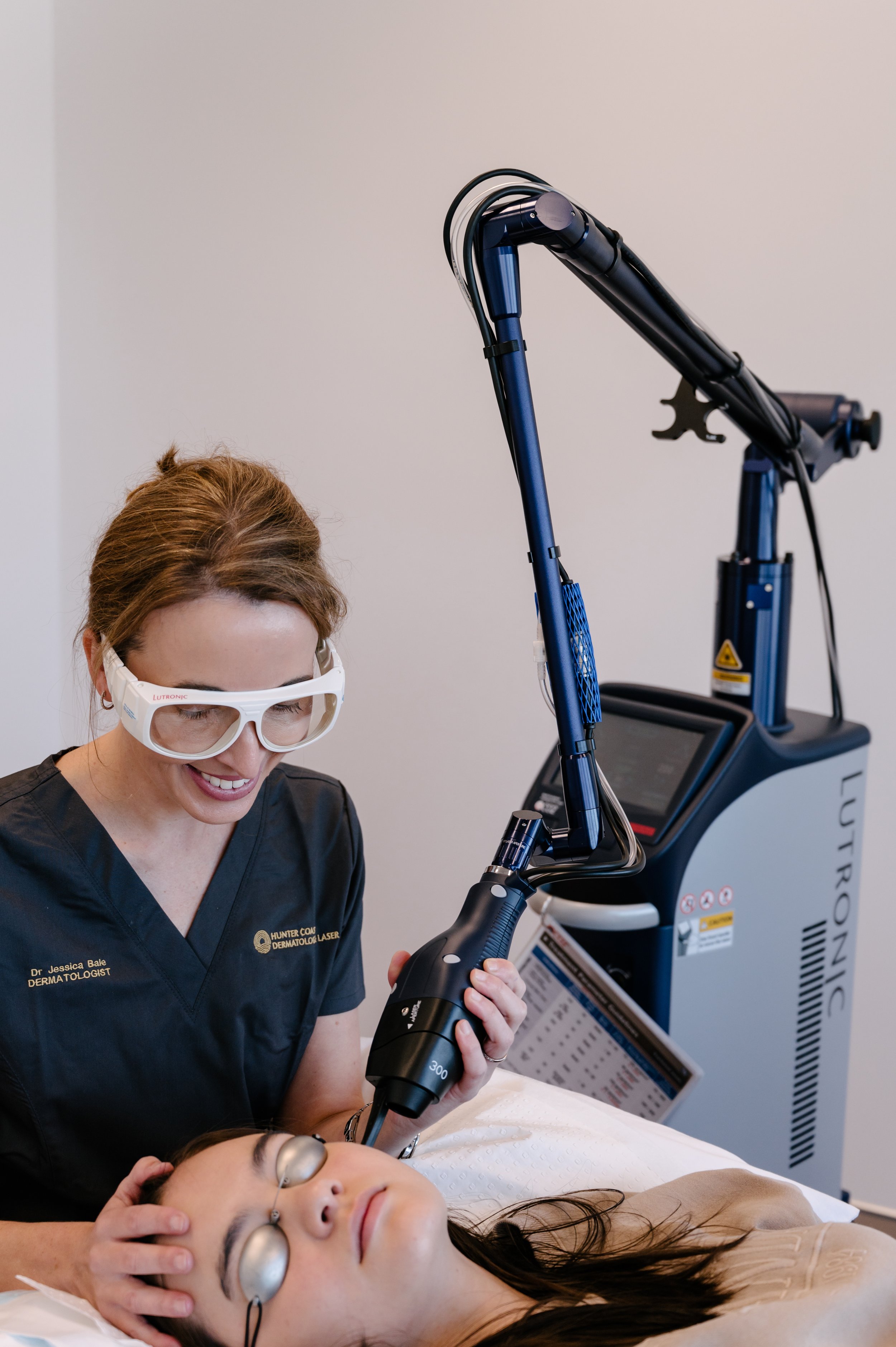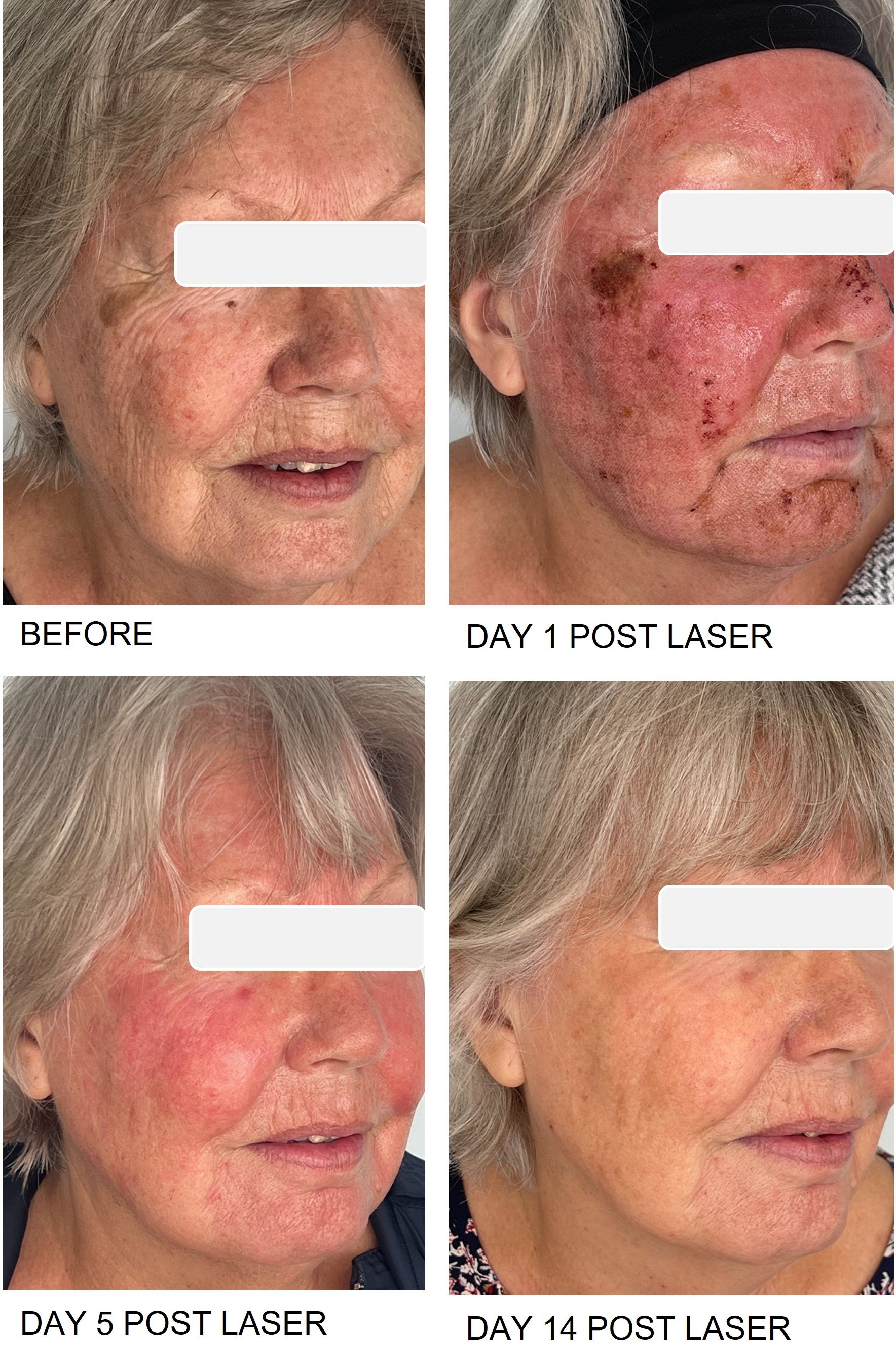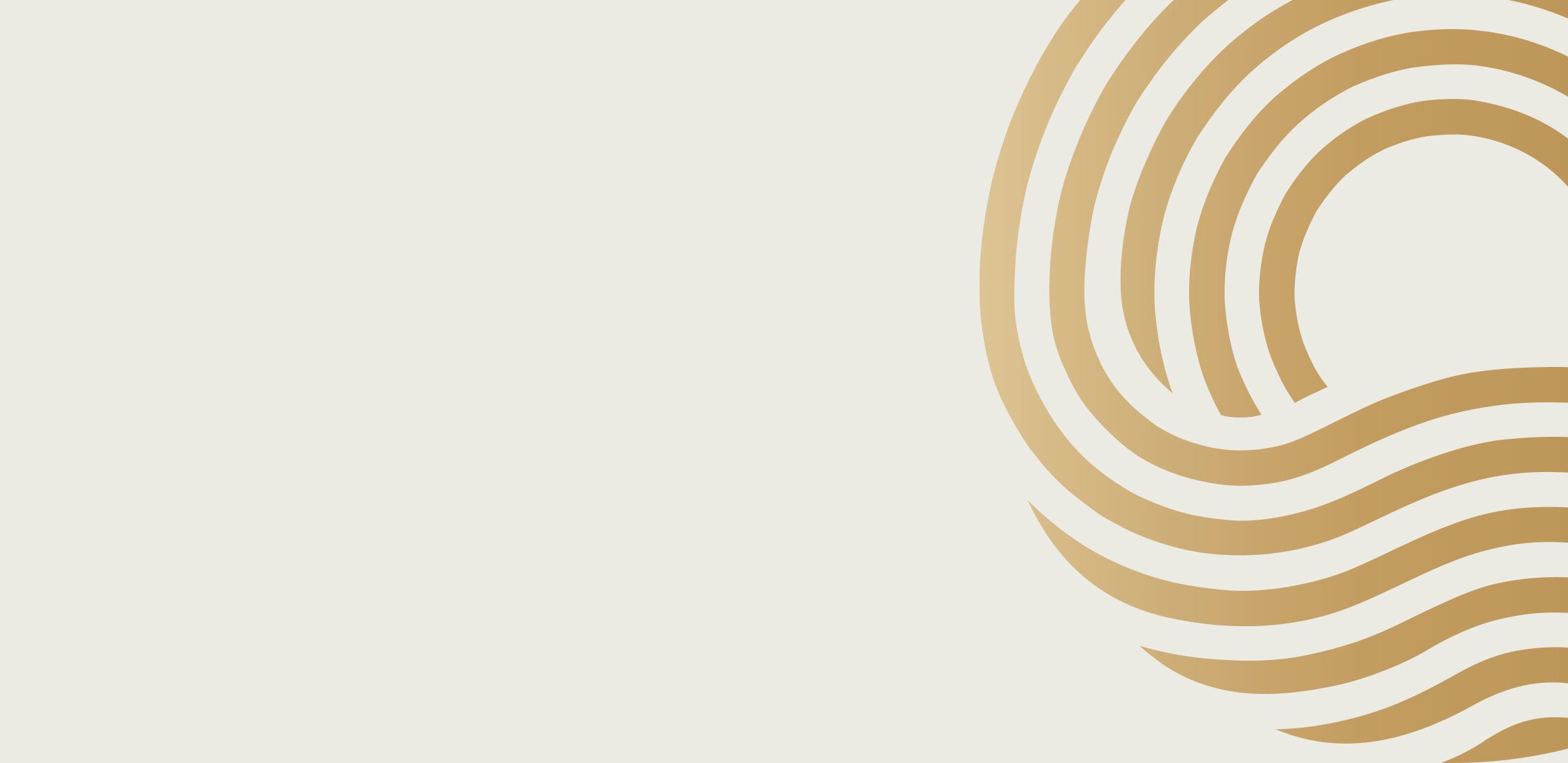
Laser Resurfacing for Rejuvenation, Solar Damage and Fine Lines
Interested in improving your skin texture, tone and sun damage?
Take our 30-second quiz to find out if our tailored, Dermatologist led medical and laser management treatments are right for your skin concerns!
What skin conditions can fractional laser resurfacing treat?
Fractional resurfacing lasers are the most advanced skin resurfacing procedures and are considered the gold standard in skin resurfacing. It is an effective and established procedure that can treat a broad range of skin conditions including:
Improves mild to extensively sun damaged skin
Reduces pigmentation and brown marks
Treats pre-cancerous lesions (actinic keratoses or ‘sun spots’)
Non-surgical treatment option for superficial skin cancers such as squamous cell and basal cell carcinoma
Removes raised and/or benign surface lesions such as seborrheic keratosis (age warts), sebaceous hyperplasia (enlarged oil glands), skin tags, and xanthelasma
Reduces fine line and wrinkles
Improves skin tone, texture and pore size
General rejuvenation of the skin
Improves scarring from acne, surgery or trauma
Treatment for rhinophyma (medical condition affecting the nose in rosacea)
Transepidermal drug delivery
Medicare rebates are available for eligible patients for treatment of actinic keratoses, superficial skin cancers, certain benign lesions and moderate to severe scarring caused by acne or trauma.
Real Patient Results | Laser Resurfacing
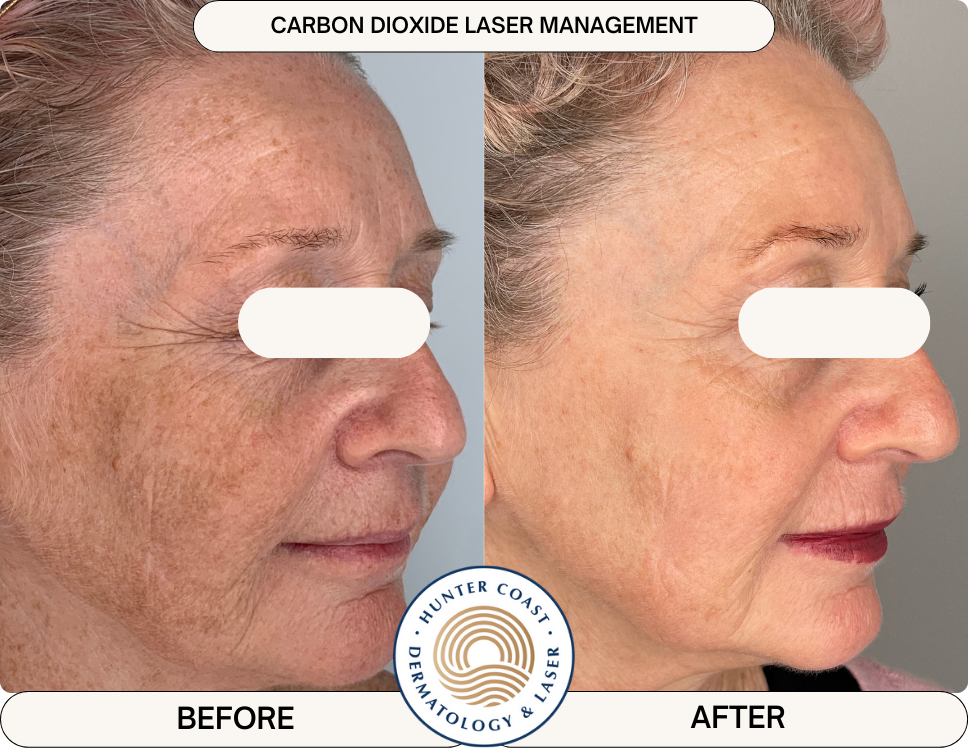
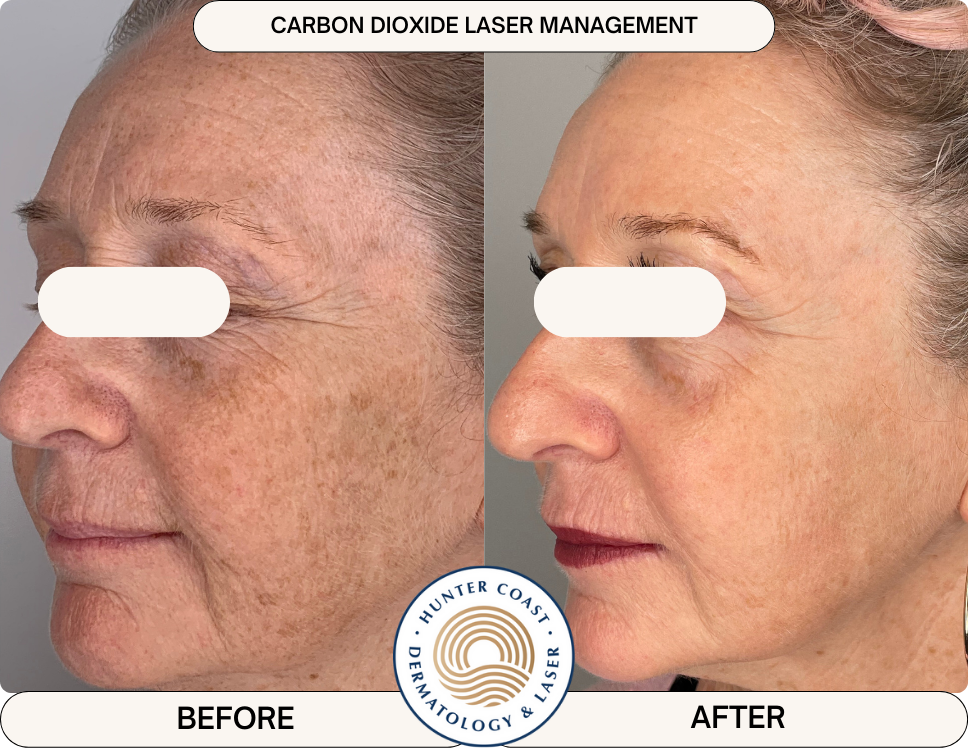
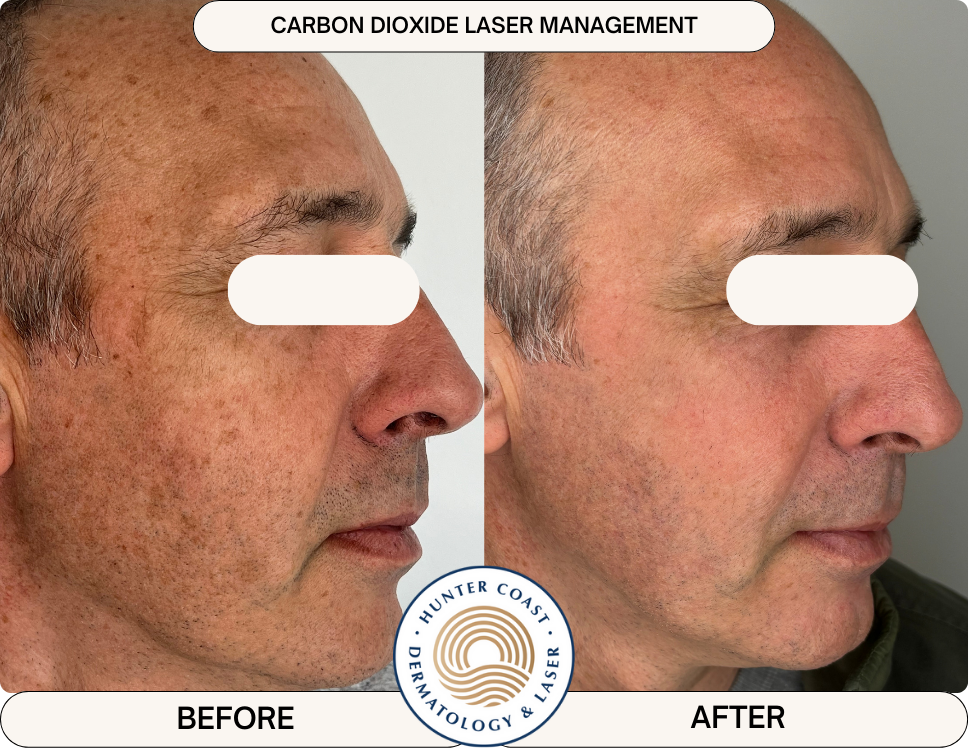
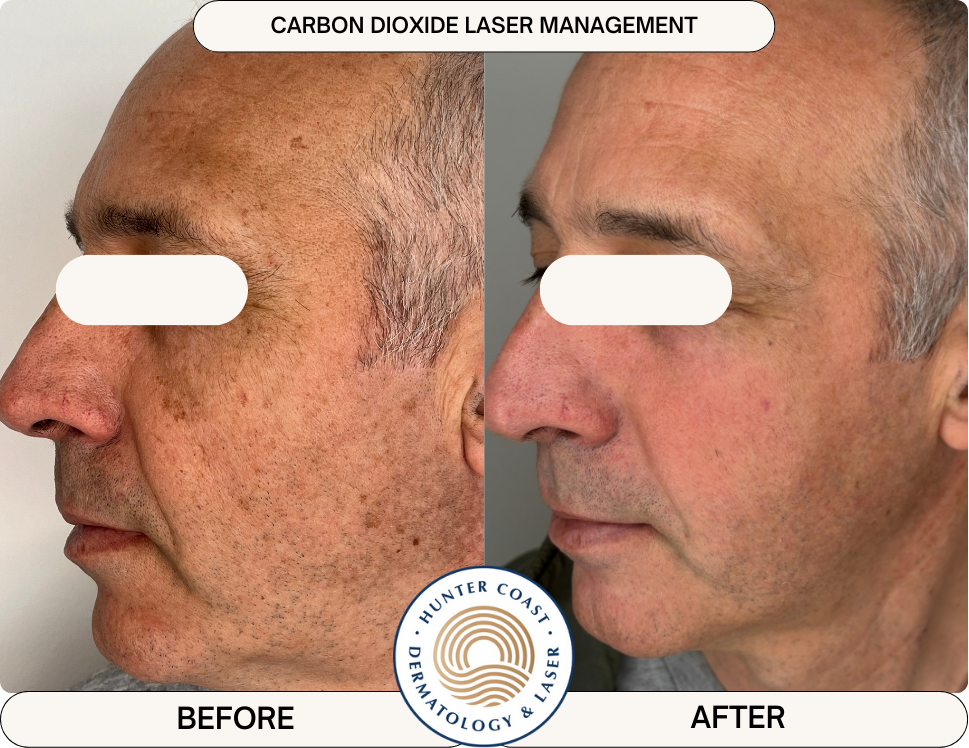
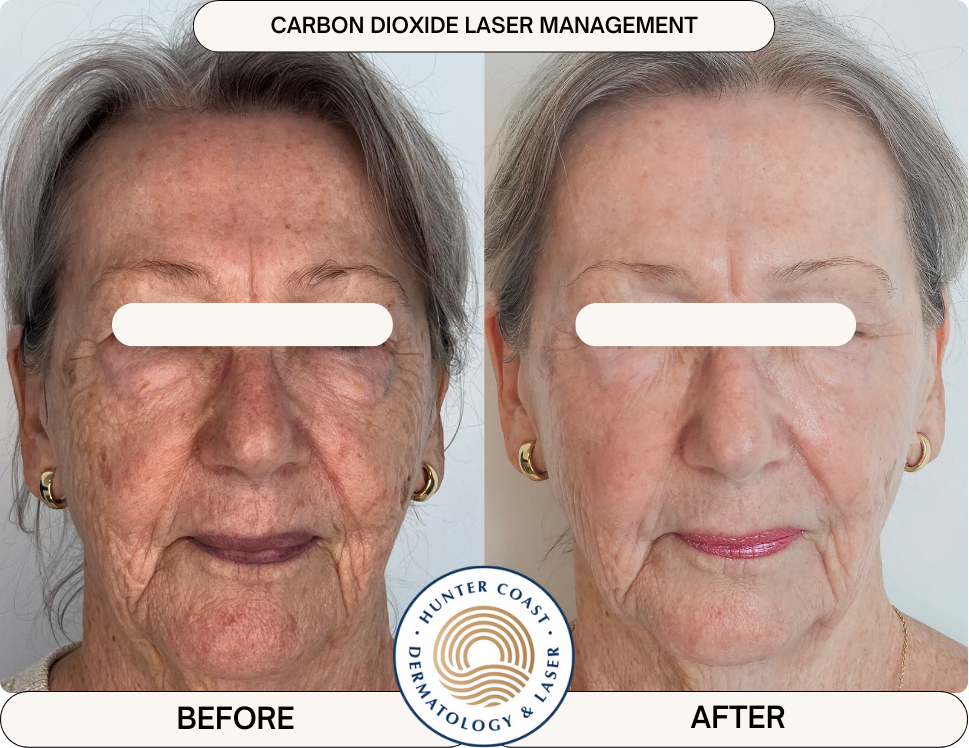
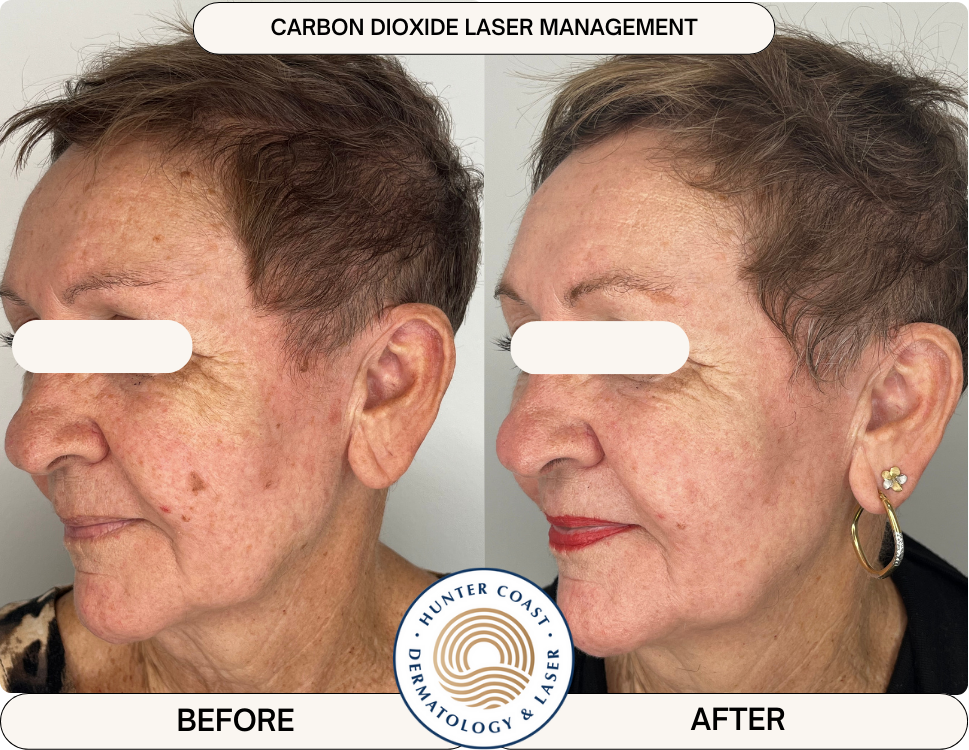
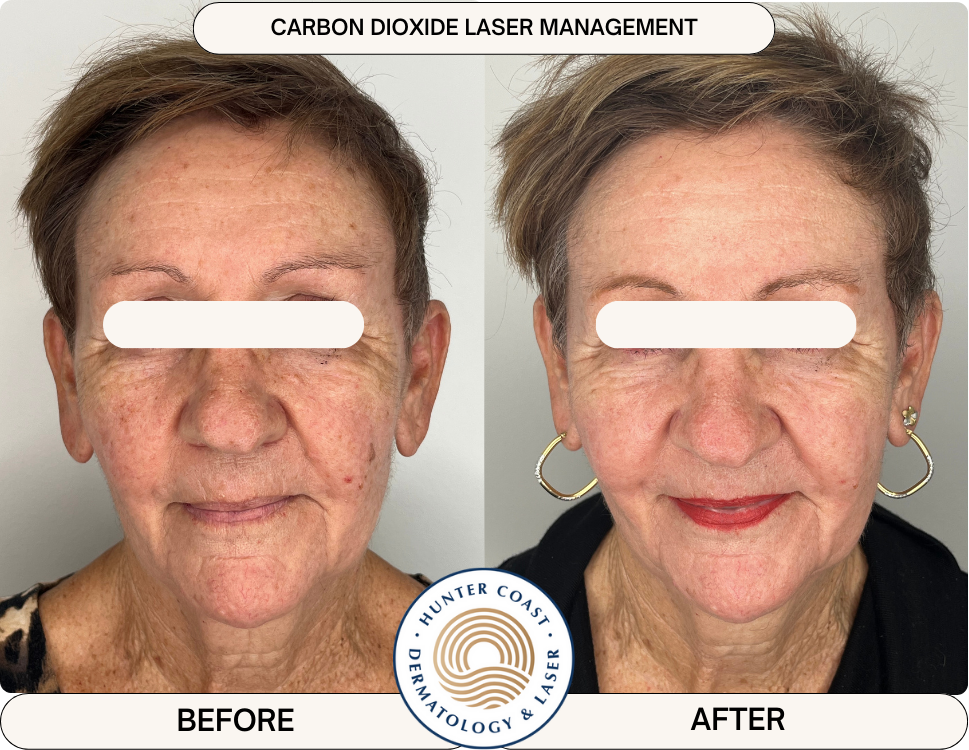
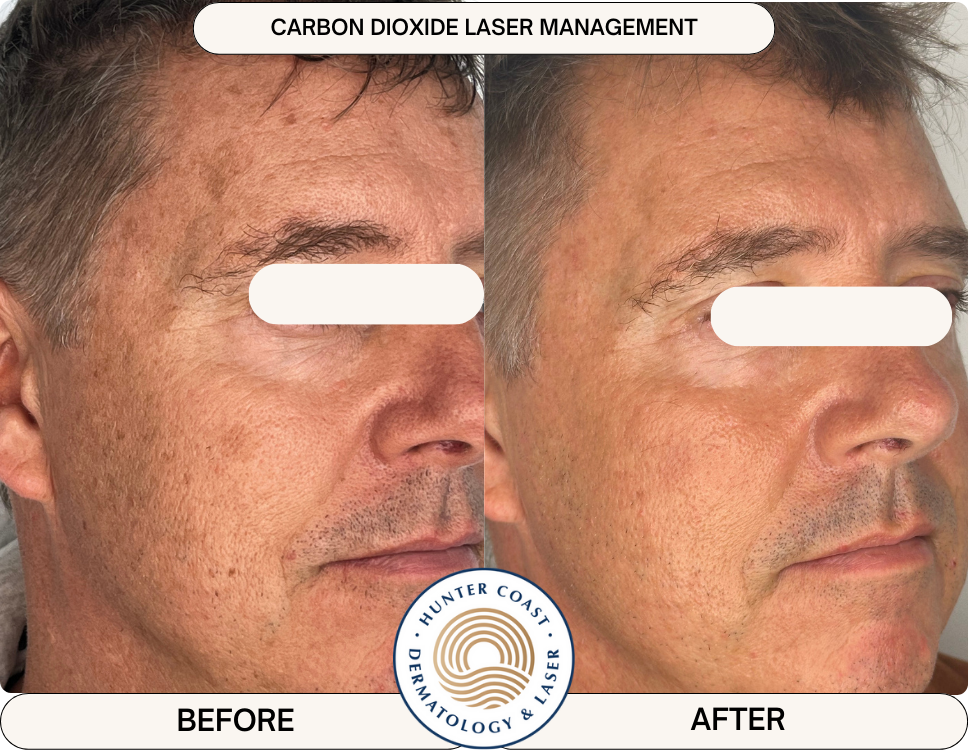
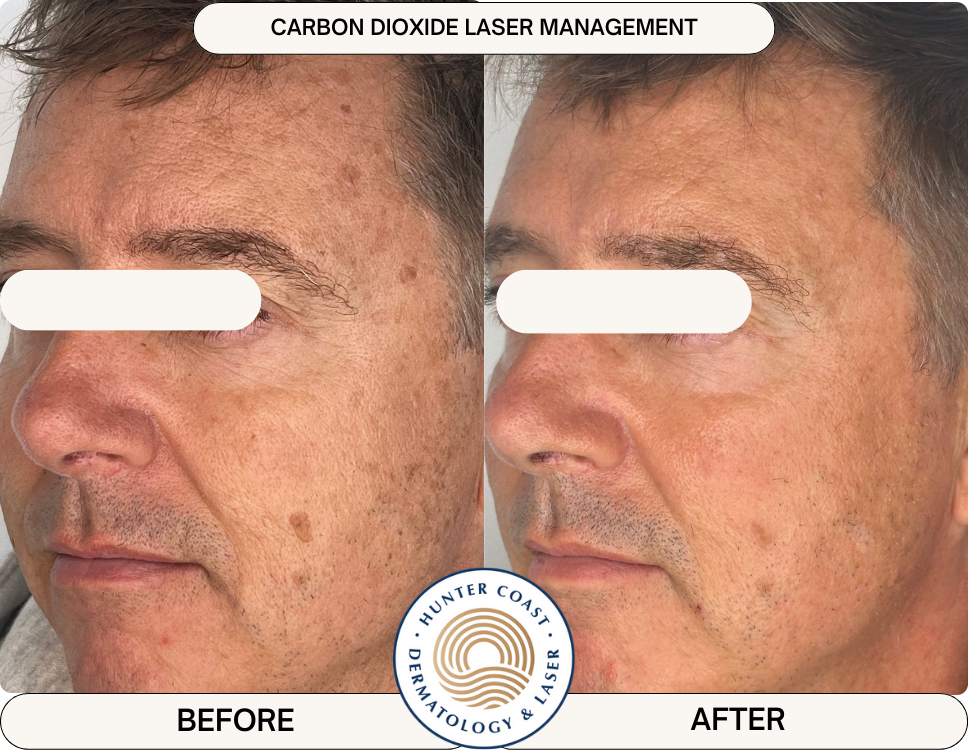
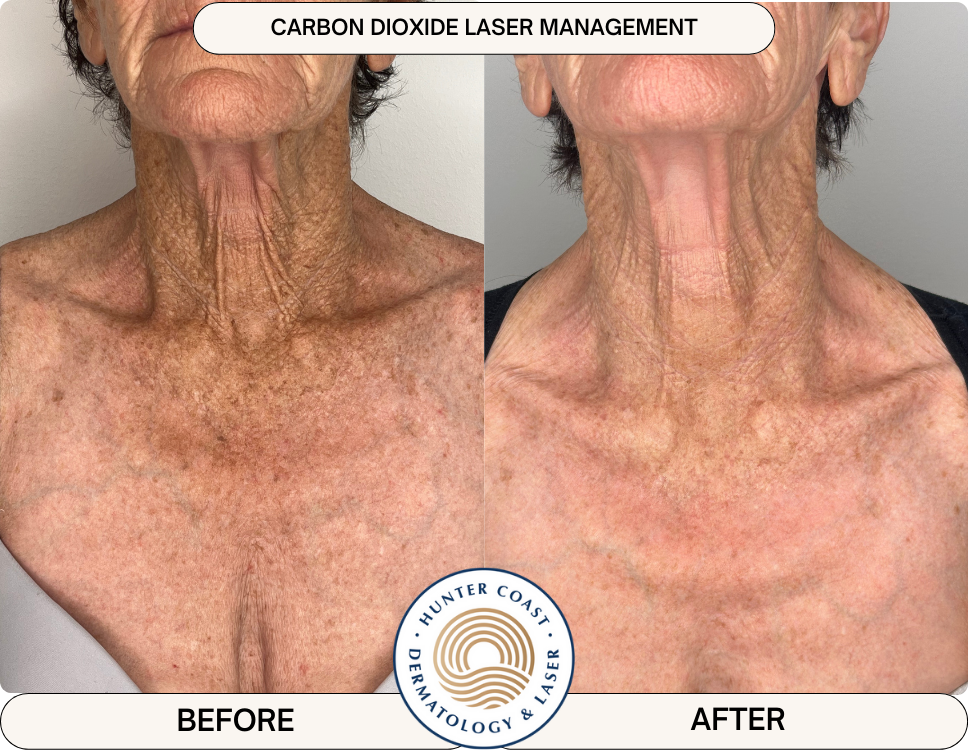
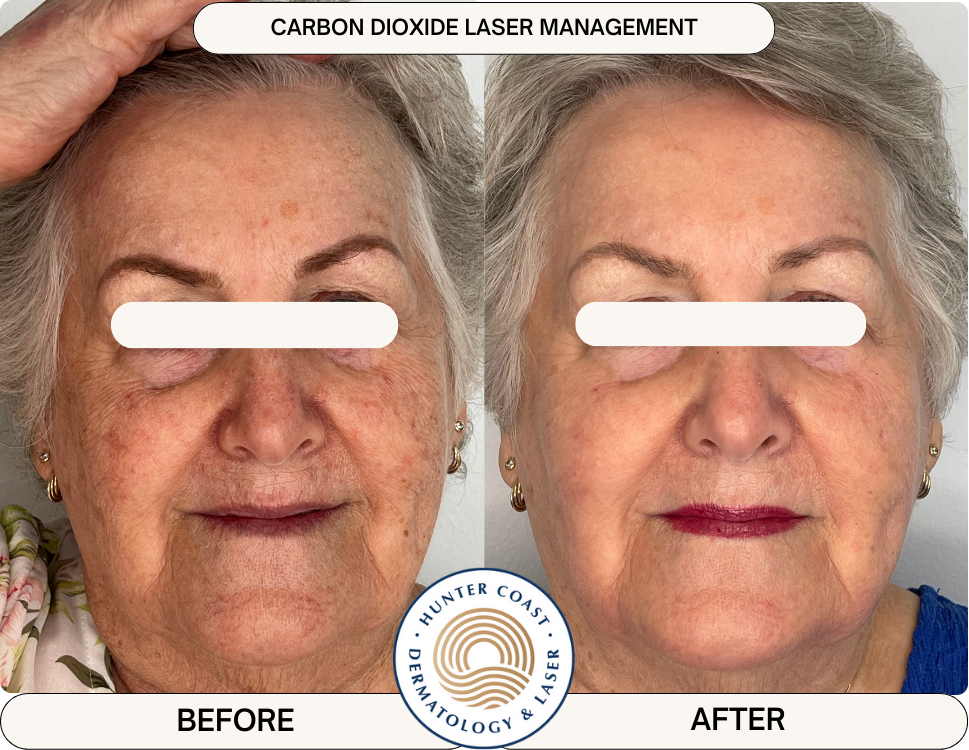
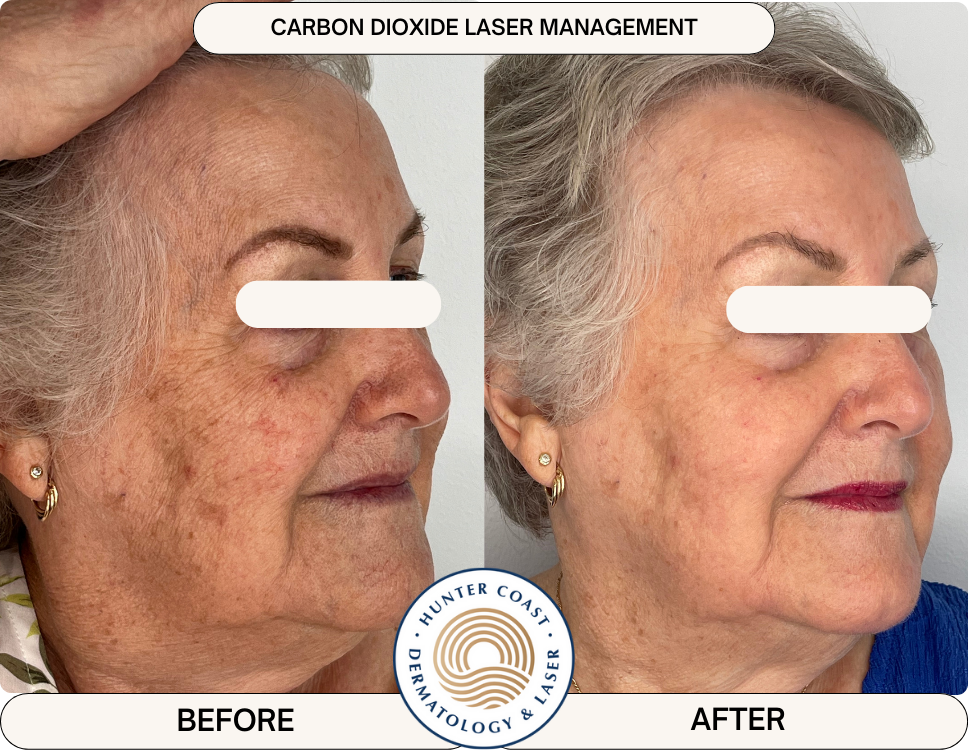
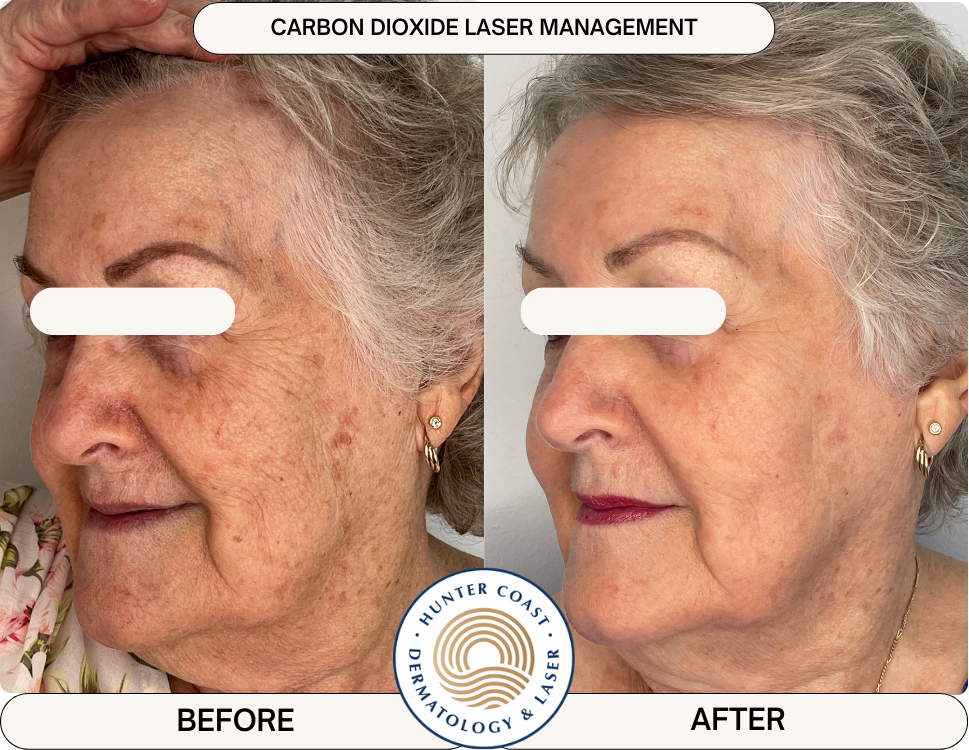
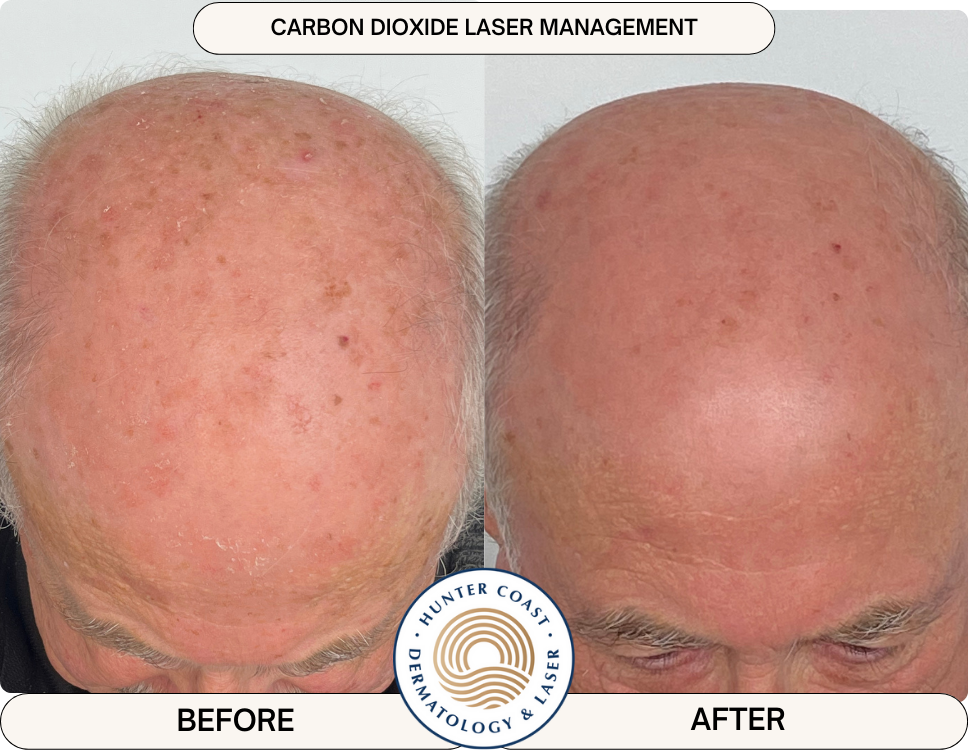
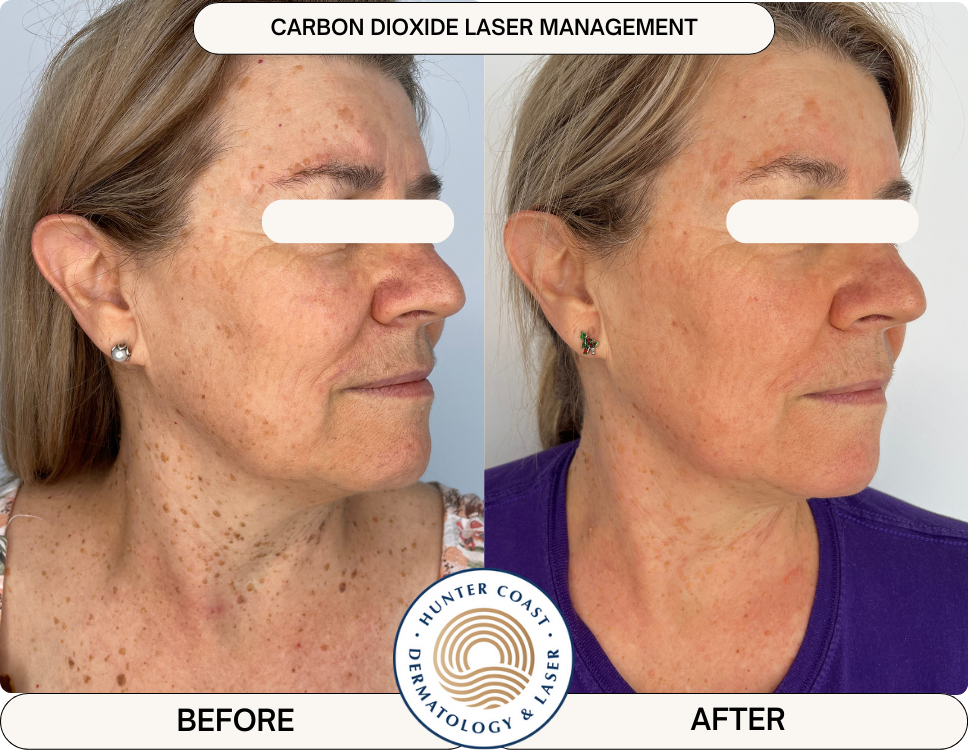
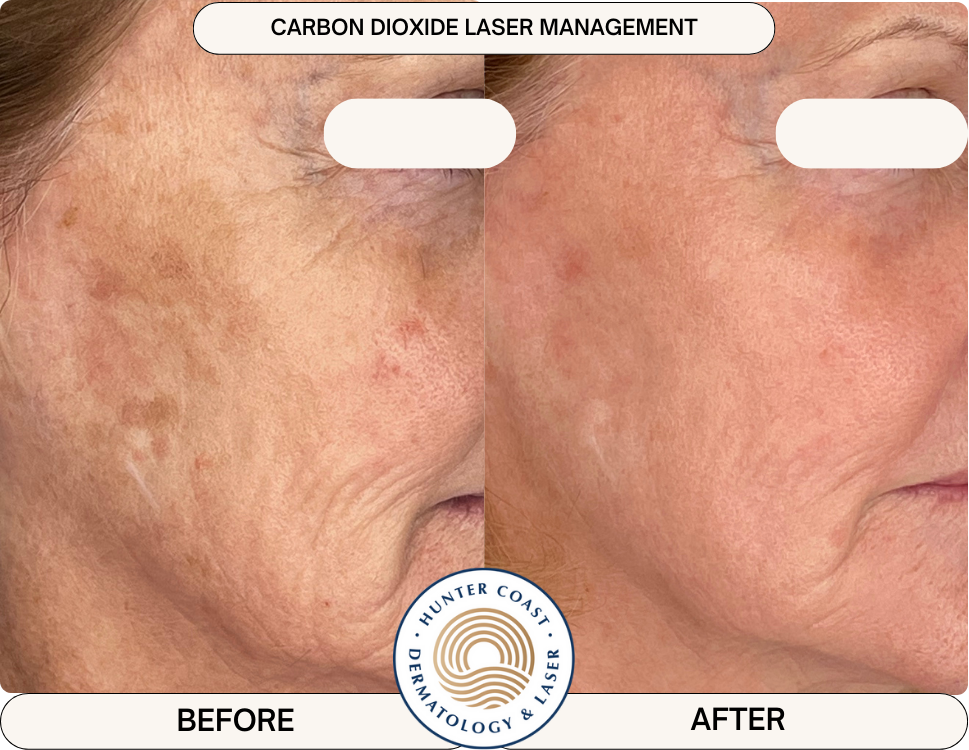

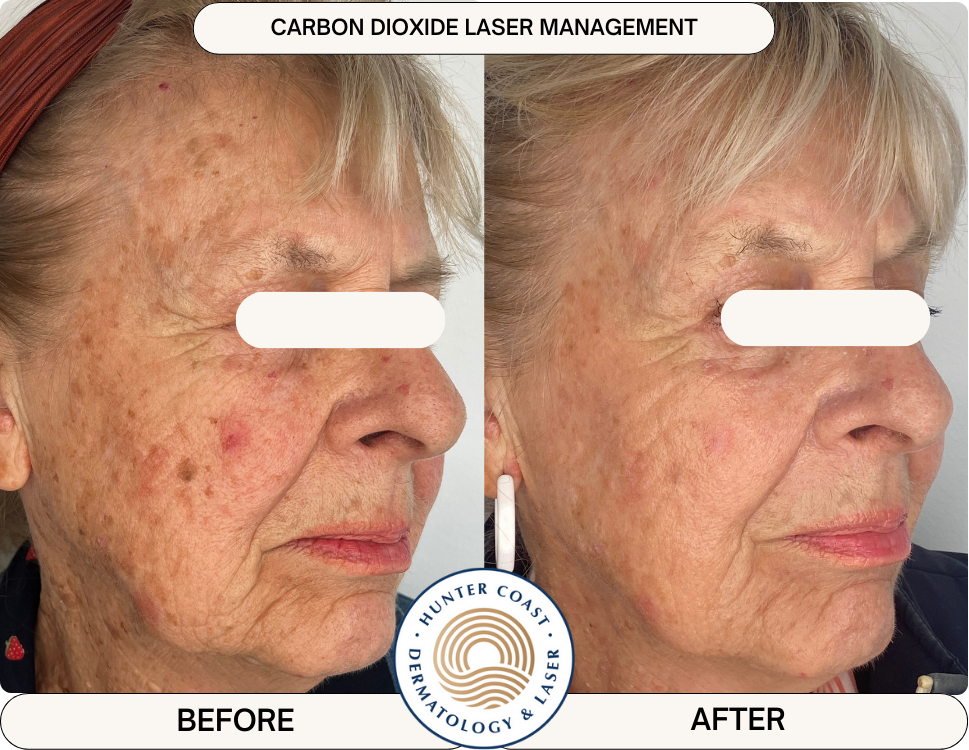
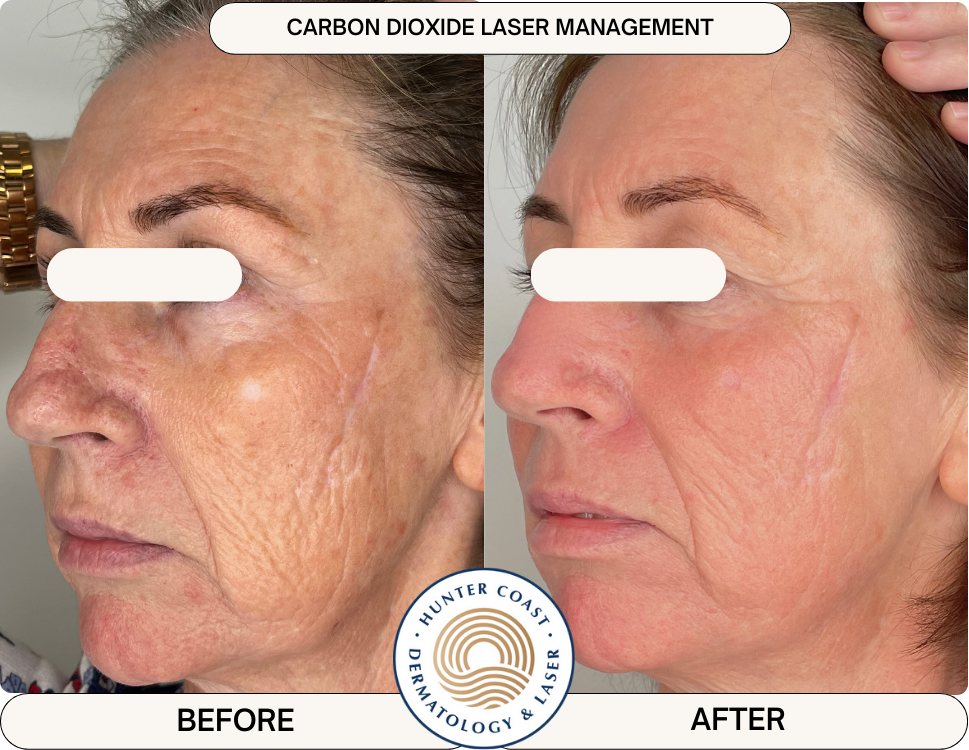
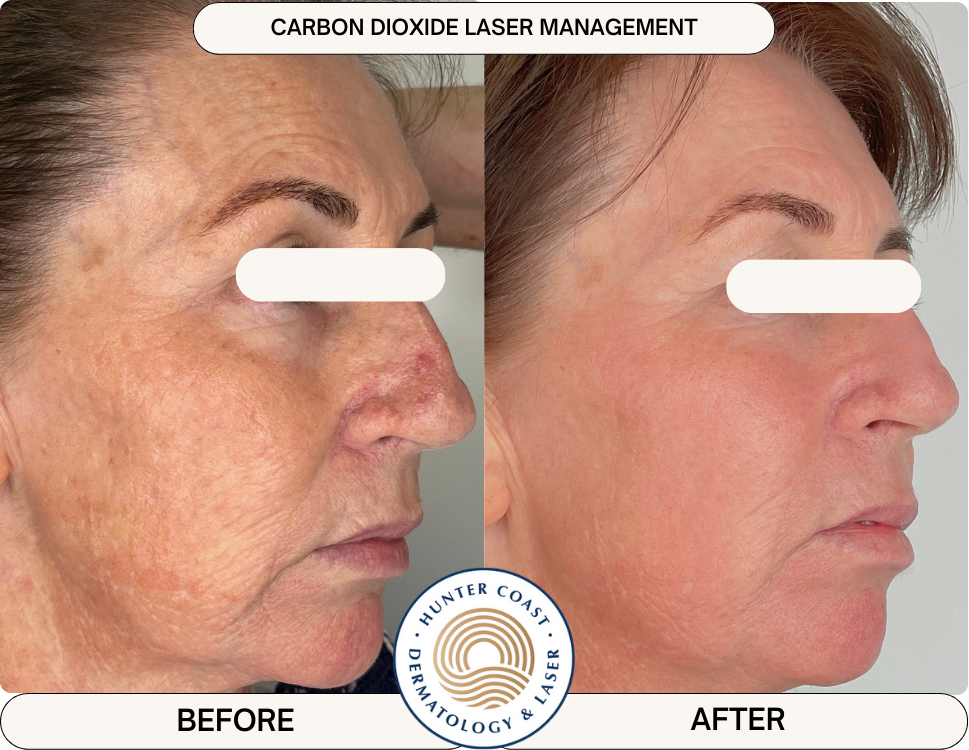
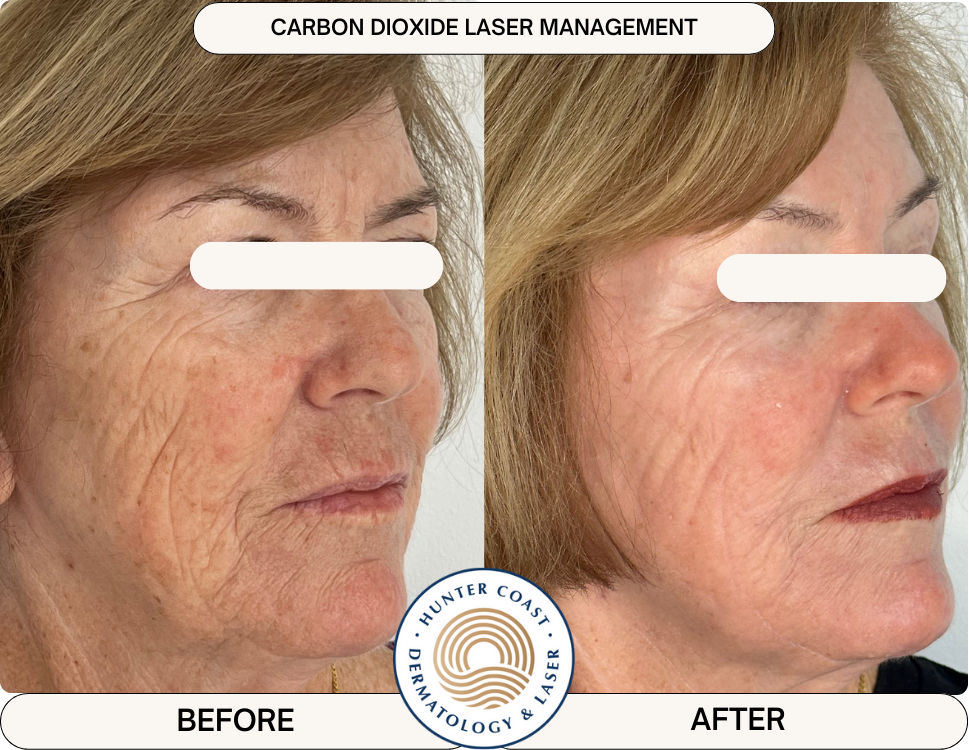
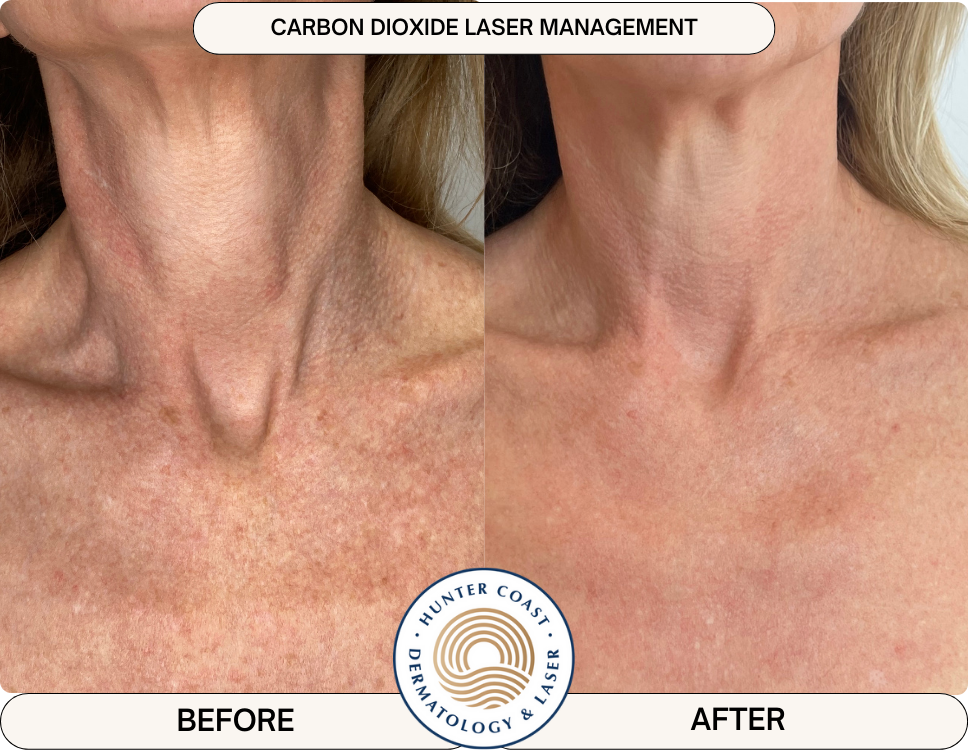


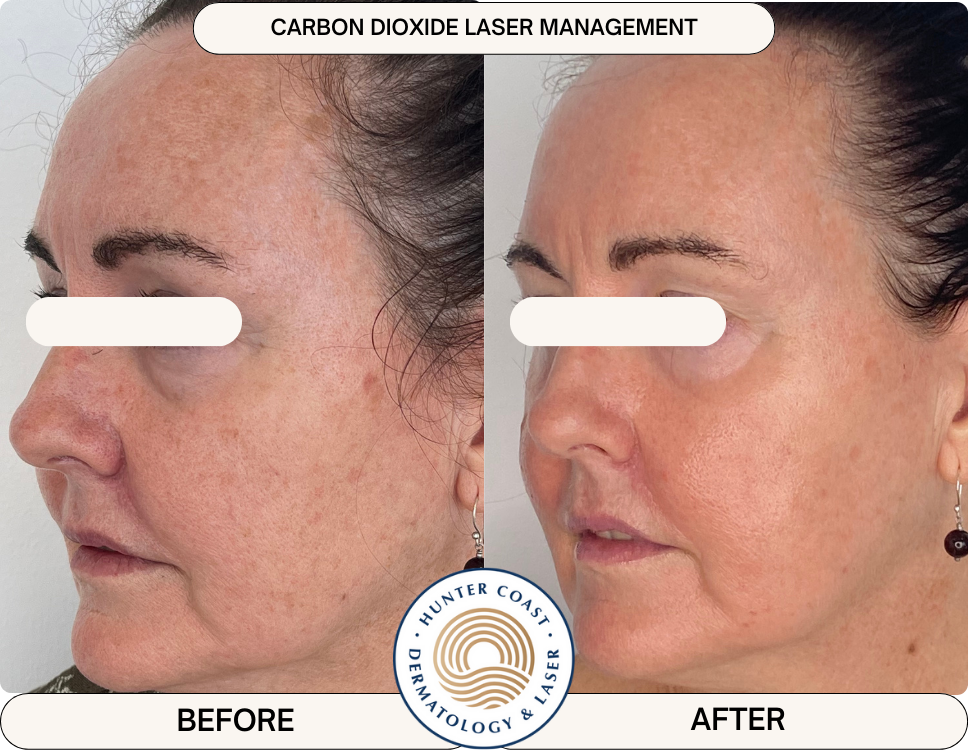
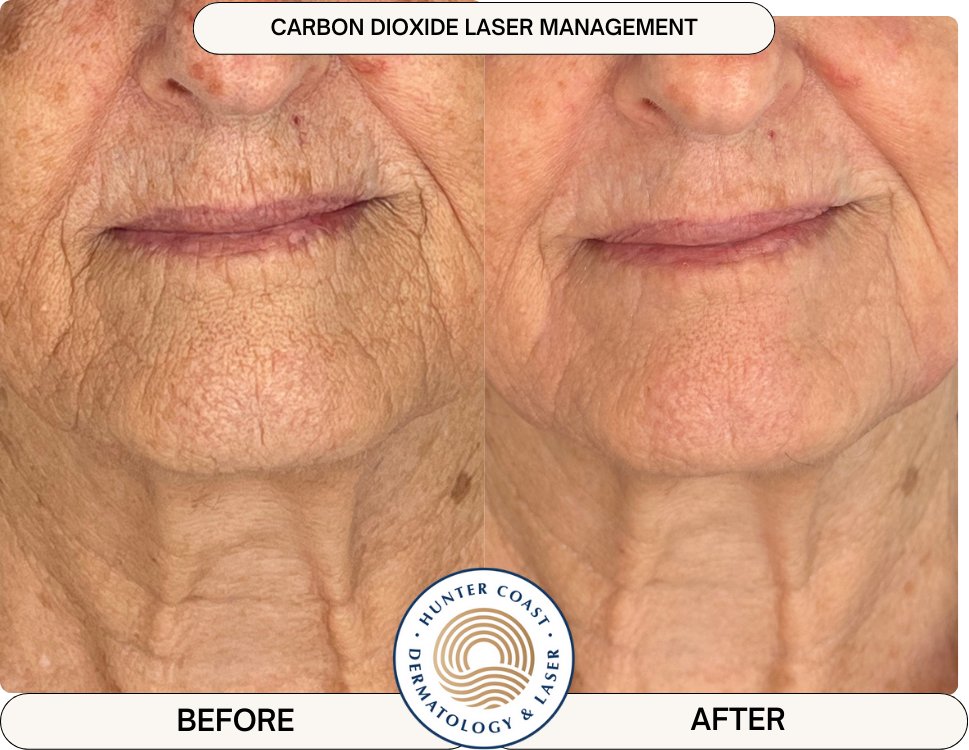

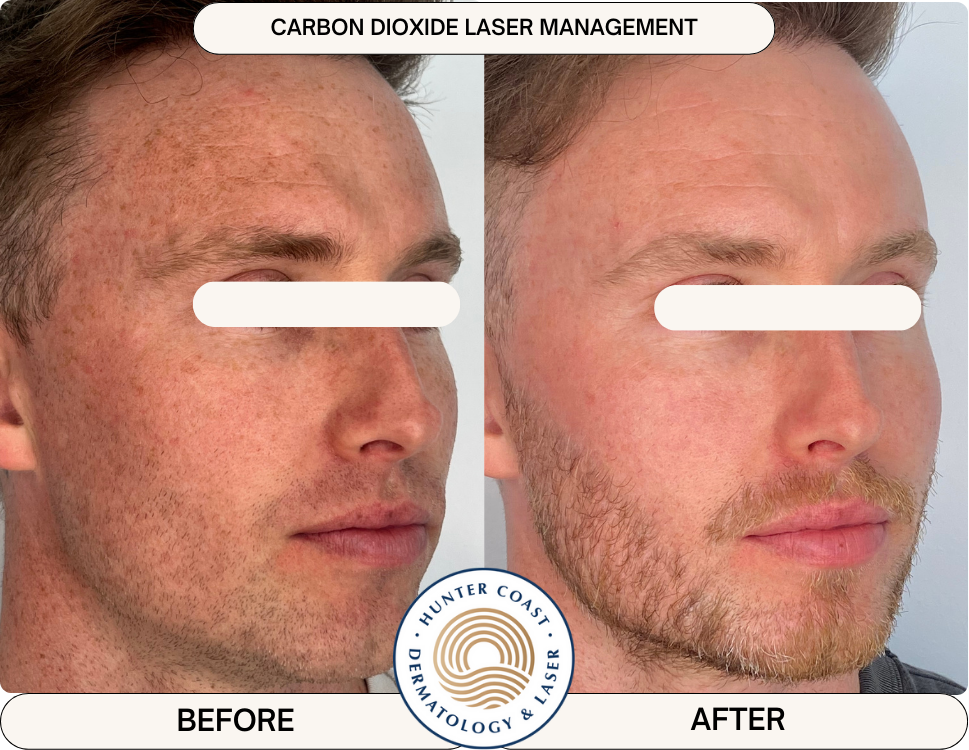
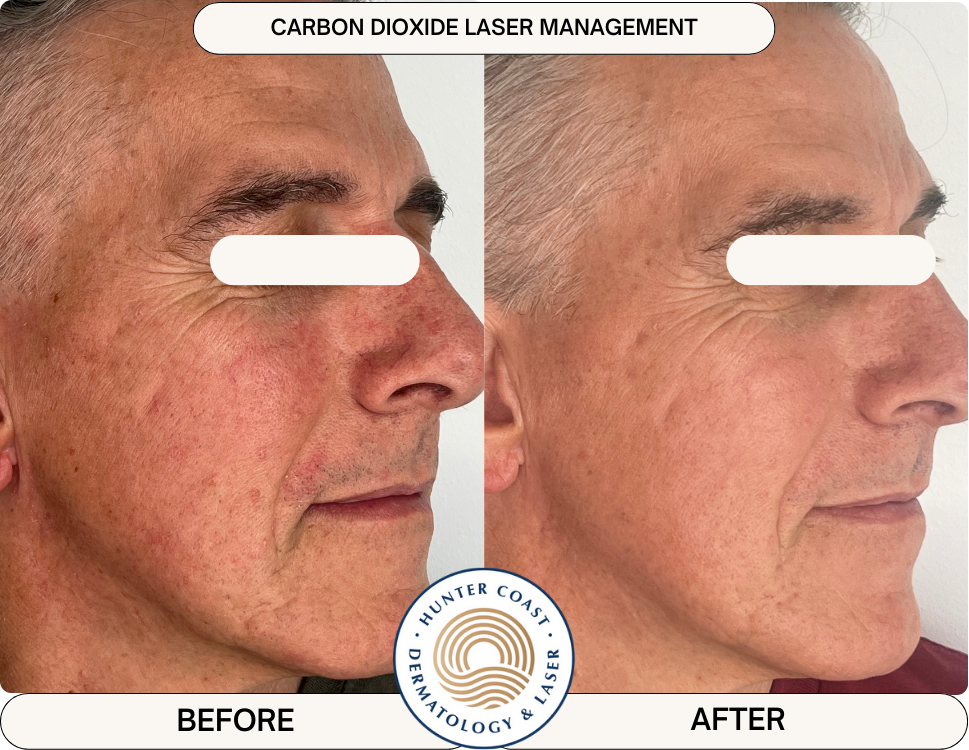
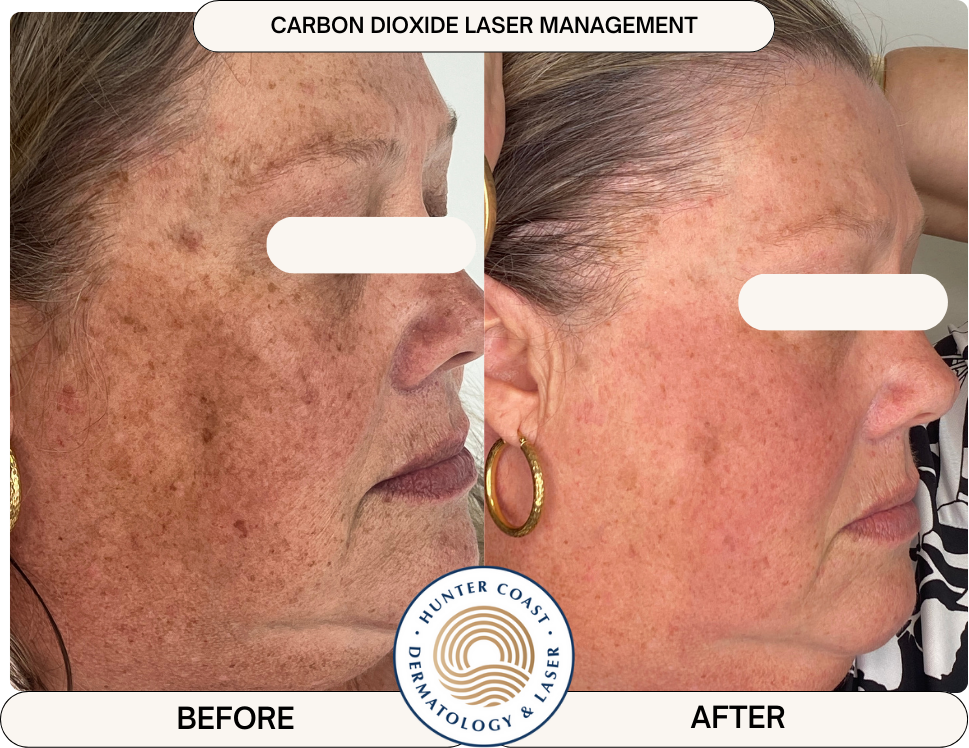
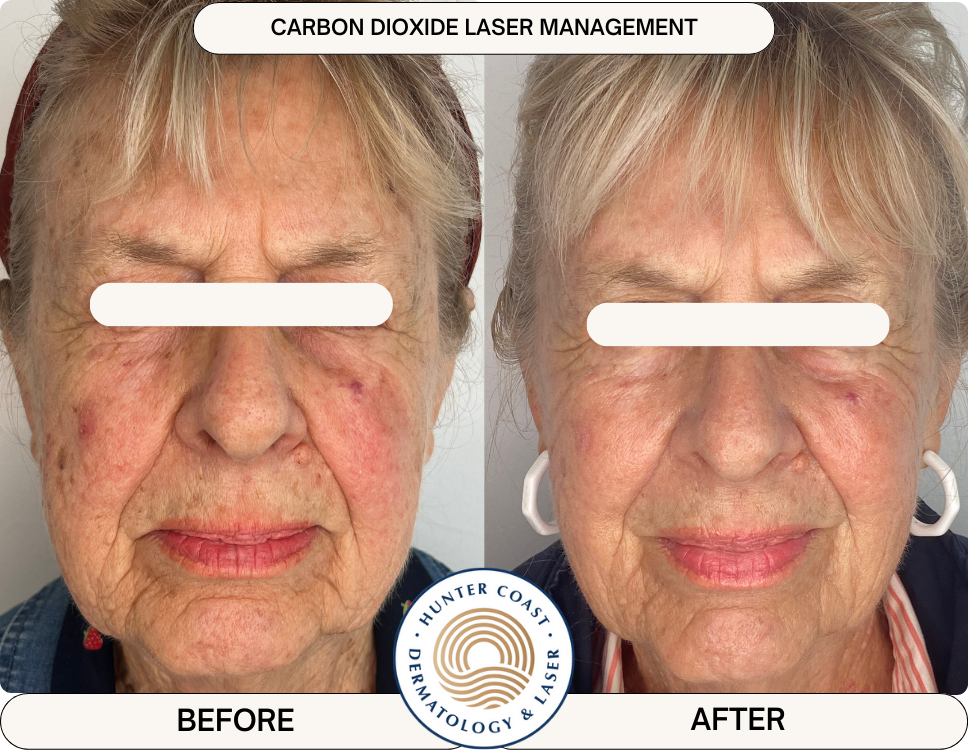
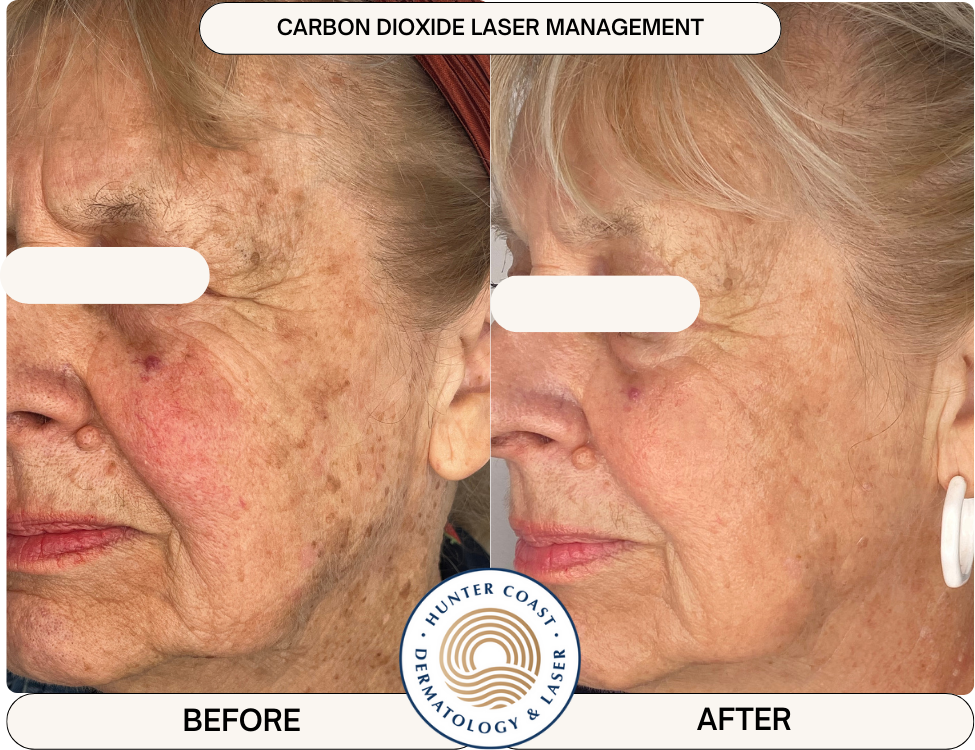

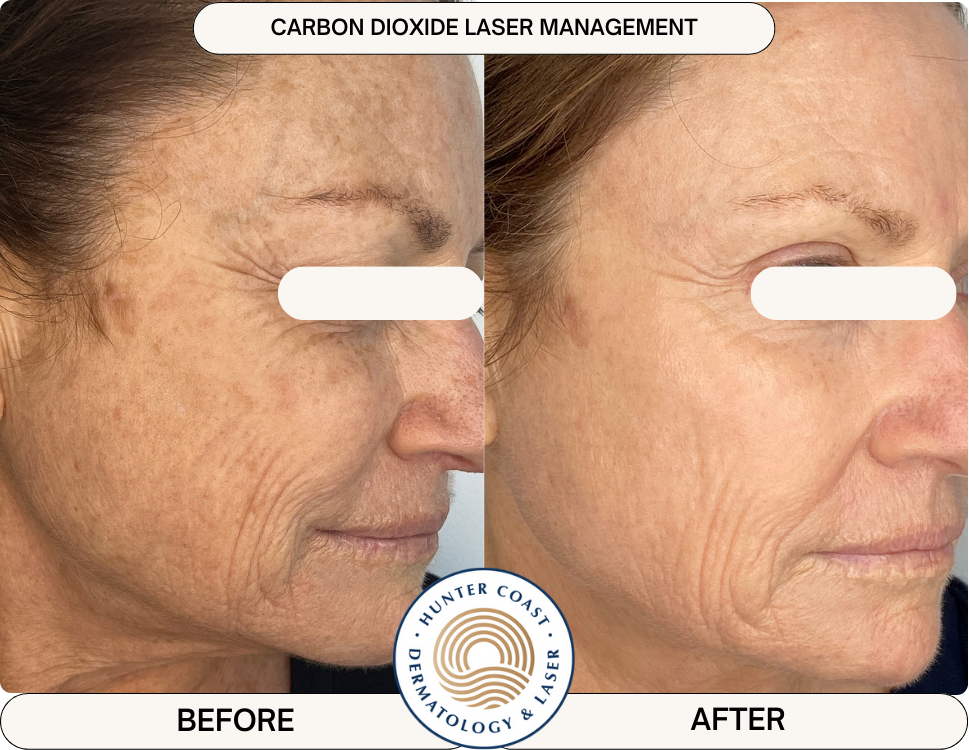
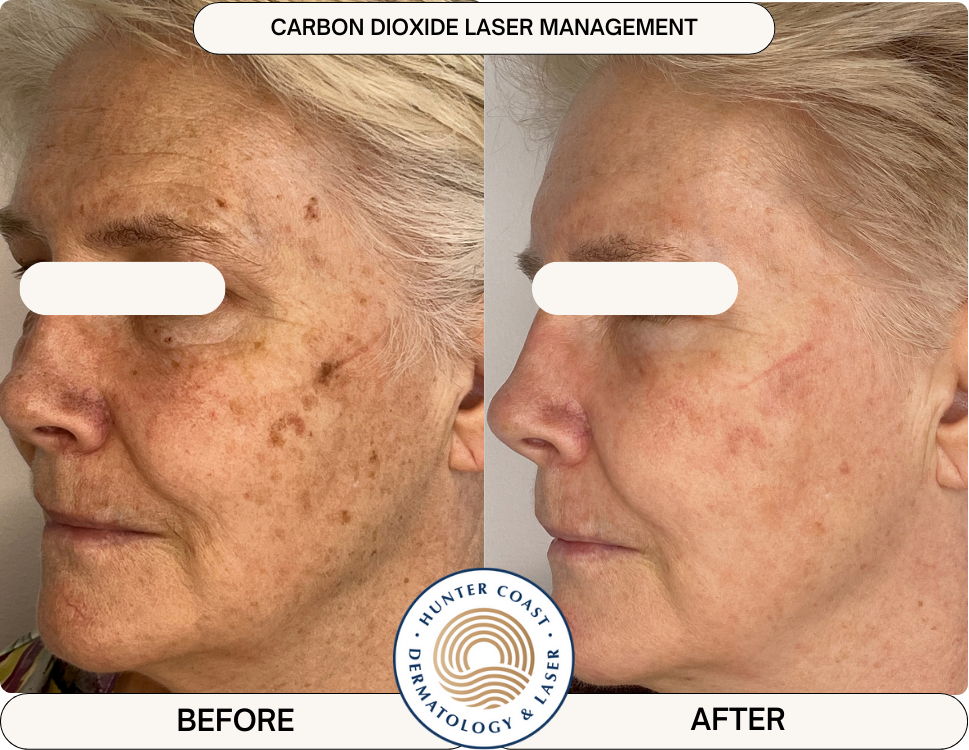
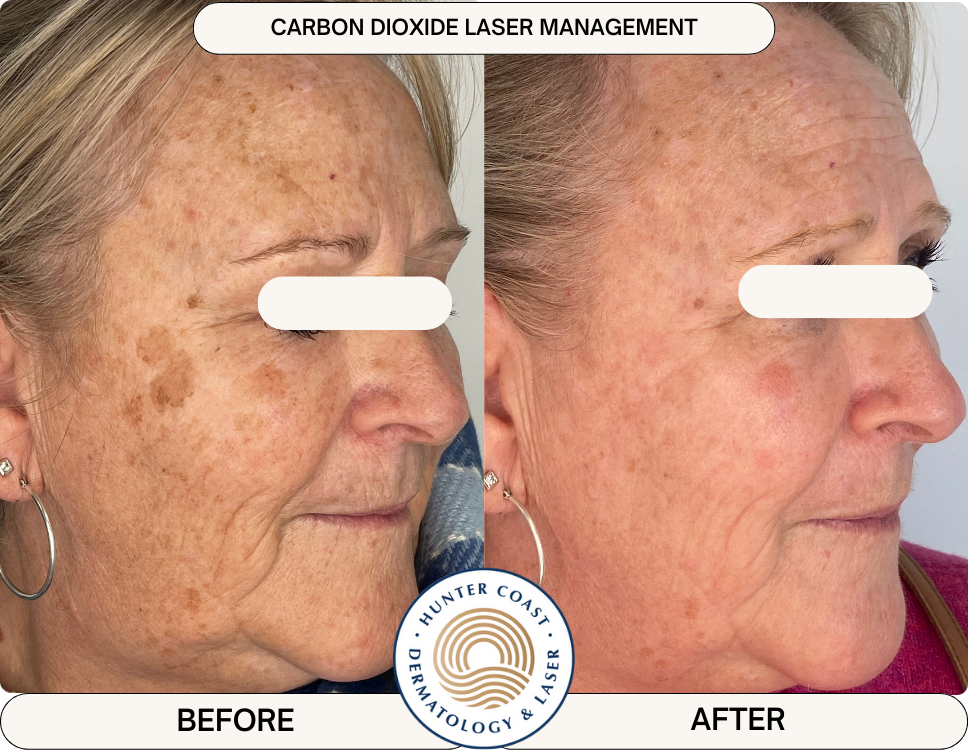
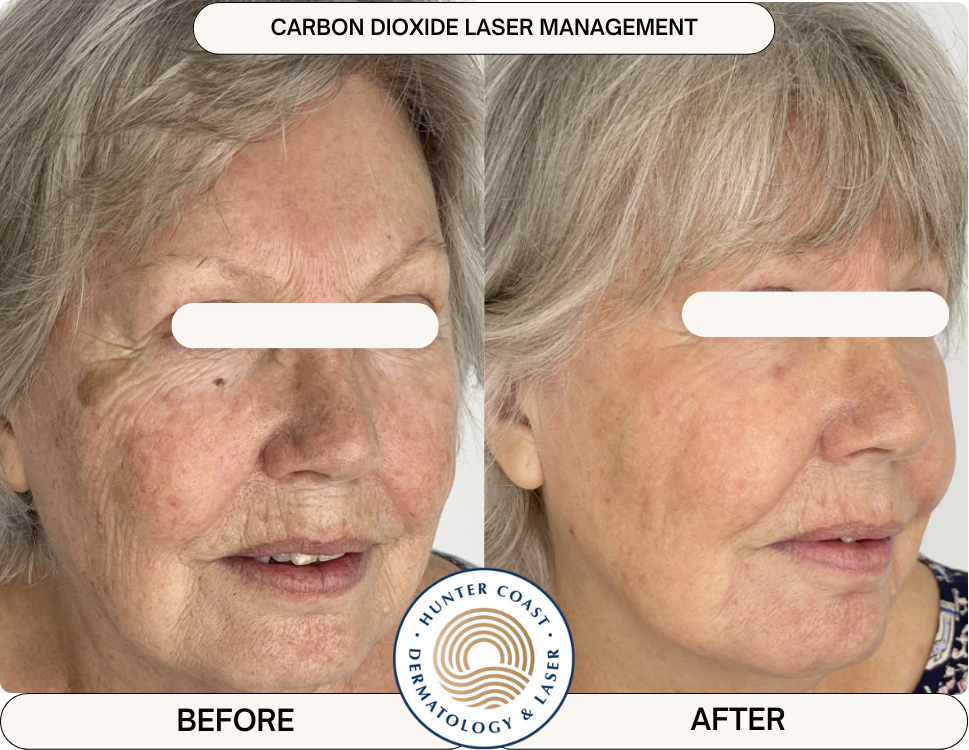

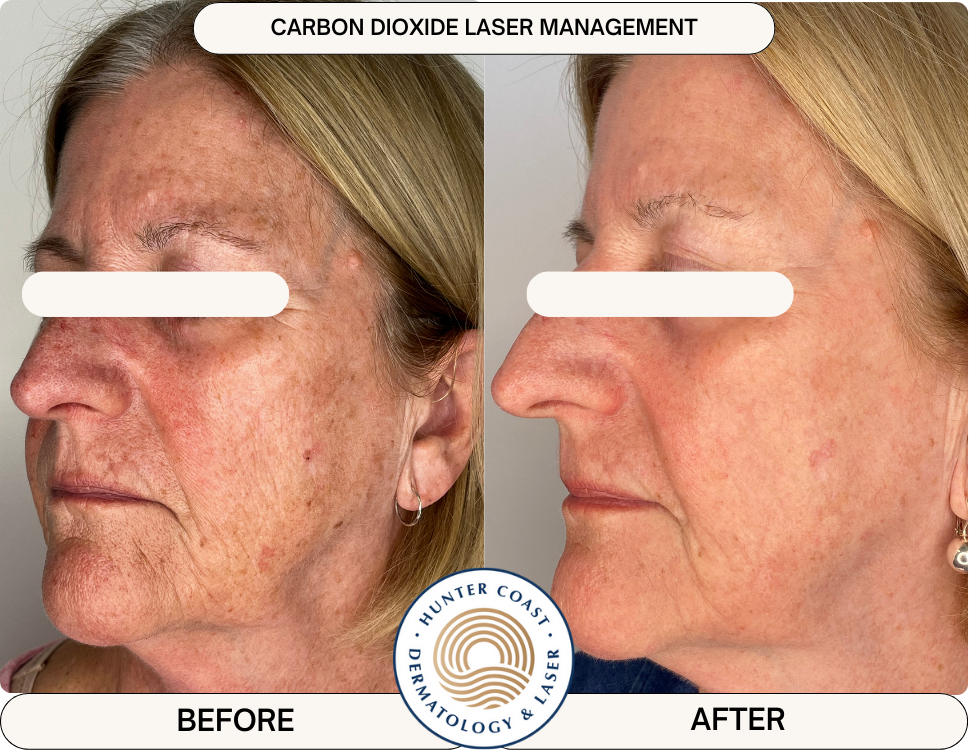

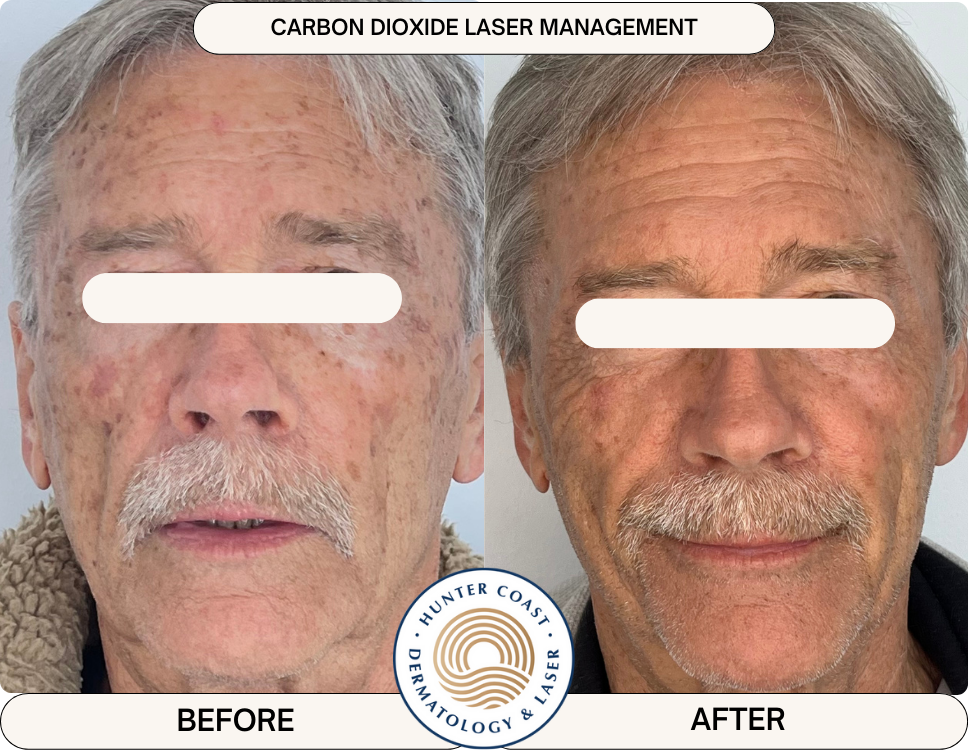

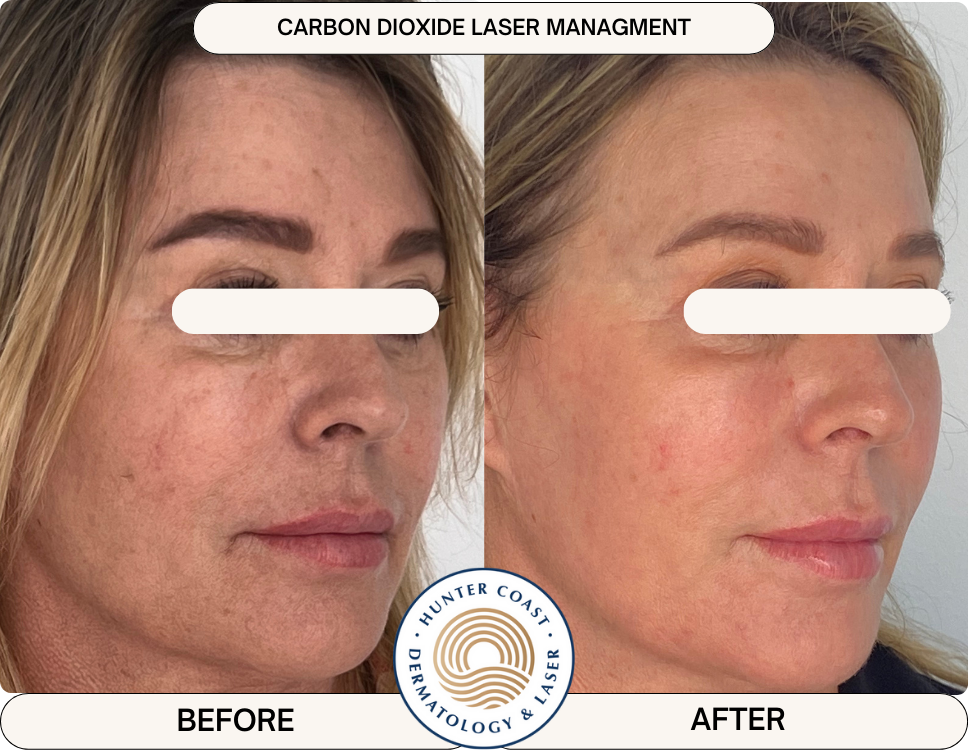
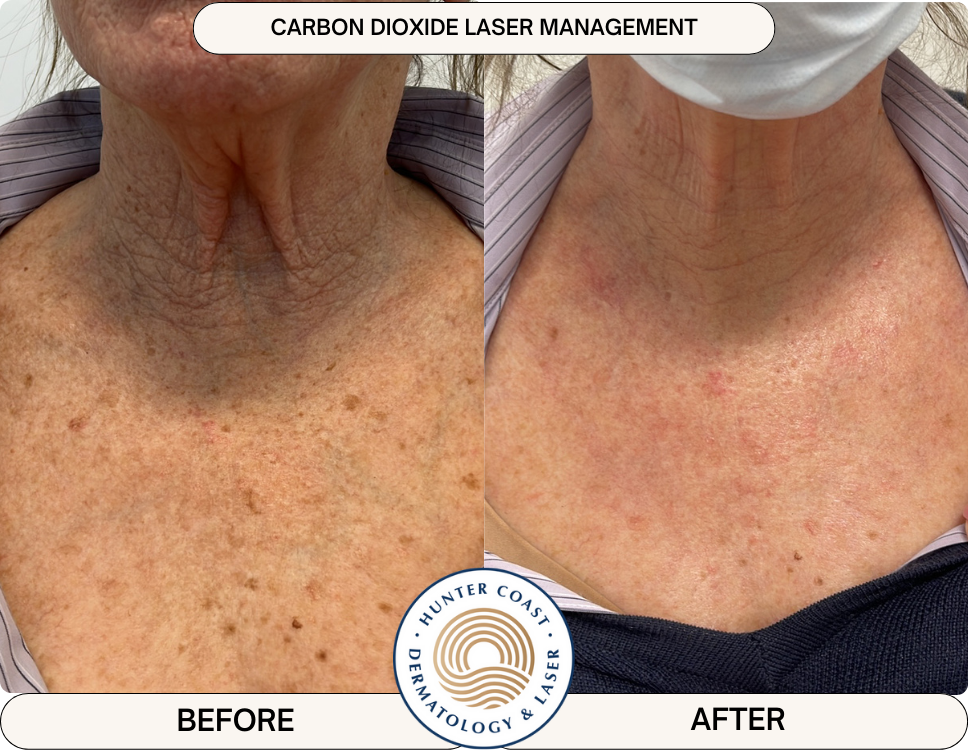
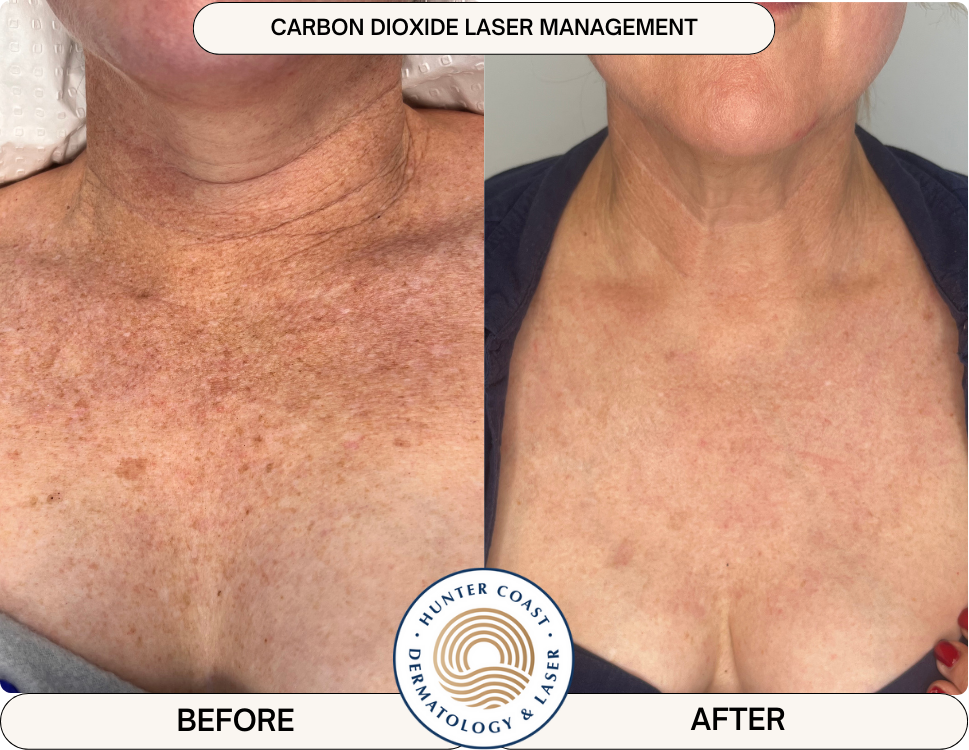
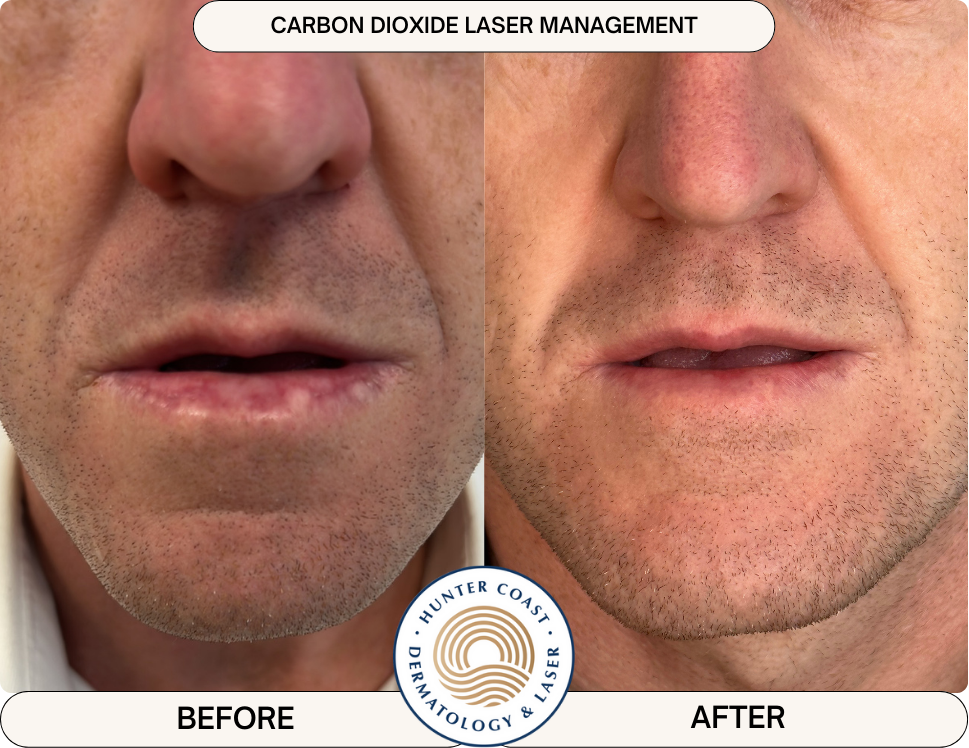
HCDL patient undergoing laser resurfacing treatment for sun damage and pre-malignant lesions, age spots, pigmentation and fine lines. This laser treatment is a very effective way to improve the signs of aging and enhance skin tone and texture.
With customised settings this laser also effectively treats scarring caused by trauma, surgery or moderate to severe acne.
How Does fractionated CO2 laser resurfacing work?
This is a specialist type of laser that treats both the upper layer (epidermis) and deeper layer (dermis) of skin. The laser uses heat and light energy to create tiny ablated ‘micro’ columns in the skin with untreated ‘skip areas’ in between. The natural healing process that follows results in the beneficial treatment effects. Fractional CO2 lasers are considered the gold standard in skin resurfacing.
In the upper layer (epidermis) it breaks up and removes sun damaged skin cells & pigmentation, removes unwanted surface lesions and results in a smoother more uniform skin surface texture.
The controlled energy delivered to the deeper layer (dermis) promotes a natural healing response with an increase in collagen and elastin production to improve fine lines, wrinkles, skin texture and general ageing appearance of the skin.
What type of resurfacing laser is used at HCDL?
At HCDL we use a particular type of CO2 laser called the eCO2. The eCO2 is a premier fractional ablative laser that has several advantages over other lasers in this category. It features the patented Controlled Chaos TechnologyTM, which creates pseudo-random microwound patterns to minimise heat build-up and maximise patient comfort. This results in an increased safety profile, with a reduction in post-operative discomfort and faster healing times with unparalleled fractional resurfacing results.
The eCO2 parameters can be adjusted to deliver treatments ranging from superficial to ultra-deep ablation. This means treatment can be tailored to match an individual’s skin concerns with recovery time they have available.
How should I prepare for my resurfacing laser?
Sun avoidance for one to two weeks prior to your resurfacing laser is suggested. Avoid irritating skin care products in the days leading up to your laser. If you are prone to cold sores you should discuss this with your treating doctor and nurses.
On the day of laser we recommend you come in with a clean face free from sunscreen and make-up.
What should I expect on the day of my laser?
Firstly, HCDL nursing staff will undertake your pre-laser assessment and provide you with all the information and after care resources. You will have the opportunity to ask any questions you may have about the procedure or recovery period.
Topical anaesthetic is then applied for approximately 1 hour prior to the laser. For medium depth treatments, injected anaesthetic is also used to make the procedure more comfortable.
During the laser you will wear eye protection and be completely awake. Ultra-chilled air (-30oC) is fanned onto the area to enhance comfort. During the treatment you will still feel a hot and prickly sensation on the skin, but with the measures mentioned above the vast majority of patients tolerate the procedure well.
After the laser is completed LED light therapy is administered for around 15 minutes which is totally painless. This is performed to enhance healing and improve outcomes. You are able to drive yourself home after the treatment.
The laser and LED therapy take around 45-60 minutes to complete.
Is the treatment painful?
Everyone experiences discomfort to varying degrees. Topical anaesthetic is applied 1 hour prior to the procedure. Cooling of the skin using ultra-chilled air (Zimmer fan) is also used for comfort. In some patients injections (nerve blocks) are utilised.
What is the recovery after the laser treatment?
The recovery will vary depending on the skin condition being treated and the laser parameters used.
Light resurfacing
Light resurfacing will have around 3-5 days of light downtime and most patients can continue to go about their usual activities apart from intensive exercise or sun exposure. In the first few days as the upper layer of skin exfoliates off it is advised to avoid sunscreen and makeup.
Medium to deeper resurfacing.
It is important to expect a longer recovery period with medium depth resurfacing which usually ranges from one to two weeks. The stages outlined below are variable and are overlapping. For medium depth resurfacing the recovery can be thought of in several stages:
· First 24hours: immediately after the laser the skin will look red and feel hot like a bad sunburn for before gradually subsiding over several hours. Discomfort is mild to moderate and can be managed with cool compress or paracetamol if required.
· 24-72 hours: redness and swelling is most prominent in the first 24-72 hours, as this slowly settles crusting and peeling of the skin occurs. Peeling will begin at around day two-three and continues for up to 7-10 days as the old skin sheds and new skin takes its place.
· 1 week: In the final stage of recovery (approx from day 5 onwards) the skin will be pink, and sensitive. Colour changes settle slowly over a 1-2 weeks but can be longer in some patients. In fairer patients the skin may be pink for several weeks before resolving.
Your dermatologist or nurse will discuss your recovery with you prior to treatment. Laser settings can be customised to suit your tolerance of downtime.
For patients who prefer lower intensity resurfacing treatments with less downtime, we offer a procedure called a micro peel. This can be performed every 4-8 weeks, and results in 24-72 hours of mild redness and peeling post-procedure. It is a gentler procedure which offers rejuvenation over a longer period of time.
Outlined below is the recovery process following medium depth resurfacing: Before, day 2, day 6, and day 14.
How do I care for my skin after treatment?
HCDL nurses will discuss your after care in detail on the day of your procedure and provide you with clear written individualised instructions. HCDL nursing team are highly trained and directly supervised by Specialist Dermatologists.
At HCDL we utilise LED light therapy immediately after laser therapy to enhance the clinical outcomes and promote faster recovery. For all medium and deeper resurfacing treatments patients are reviewed the following day and have repeat LED therapy which continues to enhance healing. If desired LED light therapy can be continued every 24-48 hours until the skin is completely healed.
When will I see results?
In the first few weeks, after the initial recovery period, the new skin will appear smoother, firmer and brighter with a reduced appearance of sun damage, brown marks and other surface lesions.
Collagen and elastin production and remodelling occurs gradually and steadily for six to nine months after laser resurfacing. Skin texture and fine lines will continue to improve over this time as new collagen is formed.
Only one treatment in needed to see improvement in sun damage, pigmentation and skin tone & texture. Additional treatments may be required for patients with particular objectives.
It is important to understand that in sun damaged skin it is normal for sun spots and pigmentation to slowly return over time and re-treatment may be needed. This interval is different for everyone.
What are the possible side effects?
Expected side effects include redness, swelling, oozing, crusting and peeling of the skin. The intensity and duration will depend on the intensity of treatment needed and will be discussed with you prior.
In trained specialist hands, serious side effects are rare. These uncommon or rare side effects can include skin colour changes or darkening of the skin (higher risk in darker skin types), infections, delayed healing, prolonged redness, scarring, acne-like eruptions.
Why should I have this treatment at Hunter Coast Dermatology?
Dermatologists are the recognised experts in all conditions and treatments relating to the skin. Dermatologists have extensive knowledge of the conditions that affect the skin, facial skin histology, anatomy and wound healing. These types of procedures should only be performed by experts in the area of skin to achieve the best and safest outcomes.
What is the cost of laser resurfacing?
The cost to have this procedure performed ranges depending on the size of area treated and the depth of treatment. Due to the nature of this procedure you need to have a consultation with a dermatologist prior who will discuss if the procedure is right for you and the costs involved. We offer telehealth appointments for patients who do not reside in the local Newcastle area wish wish to undergo laser resurfacing at HCDL.
There are Medicare rebates available for medical conditions (such as solar damage or acne scarring) treated with this laser. Your dermatologist will discuss if you are eligible for a Medicare rebate which reduces the out of pocket costs.
The recovery process following medium depth resurfacing: Before, day 1, day 5, and day 14.
Not sure if our Treatments are right for you?
Our friendly Dermal therapists and Nurses are here to help you! Our team perform a thorough and expert consultation to help you address a variety of skin concerns and discuss you skin care in detail, alongside the suitability of our cosmetic and laser based treatments.
Our Dermatologists are focused on your medical and/or surgical management and also perform certain laser based treatments and injectables.
Our team will create a thorough treatment plan tailored to you.
Contact us by calling our friendly team (02) 4003 7693 or book online today!


